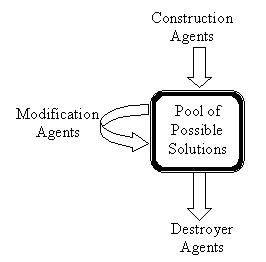Railroad Routing Optimization
The enormous scale of railroad networks and the large number of constraints in train routing make railroad routing one of the most intractable optimization problems. Also known as train pathing, it has long defied traditional operations research methods. Together with Union Switch and Signal, CISR is developing an Intelligent Agents system which is successfully solving this problem.

The Real-Time Railroad Routing System is made up of three components:
- Plan Engine
- Receives inputs about trains, schedules, and track layout;
- Uses Intelligent Agents to create an optimized movement plan.
- Plan Executive
- Converts the high-level movement plan into specific signal clears to be executed by a Computer Aided Dispatch System.
- Plan Monitor
- Continually compares the state of the railroad against the movement plan to determine if replanning is necessary.
 The Intelligent Agents perform an unsupervised parallel search of the solution space. They act autonomously and encapsulate algorithms to improve candidate solutions. The agents' autonomy and asynchronous communication result in a highly scalable system. Due to the generalized agent architecture and absence of a centralized controller, agents utilizing new algorithms are easily added. There are three types of agents:
The Intelligent Agents perform an unsupervised parallel search of the solution space. They act autonomously and encapsulate algorithms to improve candidate solutions. The agents' autonomy and asynchronous communication result in a highly scalable system. Due to the generalized agent architecture and absence of a centralized controller, agents utilizing new algorithms are easily added. There are three types of agents:
- Construction agents, which seed a pool with possible solutions;
- Modification agents, which make incremental changes to the solutions;
- Destroyer agents, which remove unpromising candidate solutions.
These systems are effective at solving intractable problems where there are many heuristics available to improve solutions, but none works well alone.

